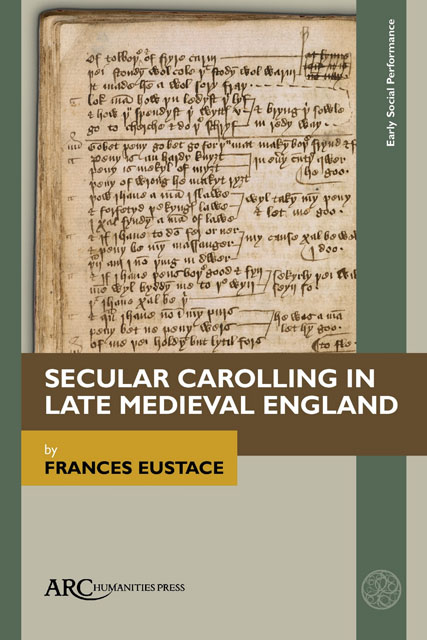Book contents
- Frontmatter
- Contents
- List of Illustrations
- Preface
- Introduction
- Chapter 1 Carolling and Dance-Song in the Context of a Primarily Oral Culture
- Chapter 2 Courtly Carolling: Contexts and Practices
- Chapter 3 The Church, Carolling, and the Emergence of the English Franciscan Carole Writers of The Fourteenth and Fifteenth Centuries
- Chapter 4 Carole Texts in Context: The Manuscripts
- Chapter 5 Carole Texts as Witnesses to Carolling Practice
- Chapter 6 Survivances Of Carolling In Folk Culture
- Conclusion: Carolling from a Dance Movement Psychotherapy Perspective
- Bibliography
- Index
Conclusion: Carolling from a Dance Movement Psychotherapy Perspective
Published online by Cambridge University Press: 06 April 2023
- Frontmatter
- Contents
- List of Illustrations
- Preface
- Introduction
- Chapter 1 Carolling and Dance-Song in the Context of a Primarily Oral Culture
- Chapter 2 Courtly Carolling: Contexts and Practices
- Chapter 3 The Church, Carolling, and the Emergence of the English Franciscan Carole Writers of The Fourteenth and Fifteenth Centuries
- Chapter 4 Carole Texts in Context: The Manuscripts
- Chapter 5 Carole Texts as Witnesses to Carolling Practice
- Chapter 6 Survivances Of Carolling In Folk Culture
- Conclusion: Carolling from a Dance Movement Psychotherapy Perspective
- Bibliography
- Index
Summary
IN THIS BOOK we have seen that medieval carolling was an activity enjoyed by people from all levels of society, from the highly educated clerics and most sophisticated courtiers down to the illiterate peasant. The carole form was flexible and adaptable, and singing or dancing ability were no criteria for, or against, communal participation, although the inventiveness of the lead singer and their ability to project in a clear, tuneful voice was considered necessary. Participation could be spontaneous, meaning that no rehearsal was required, and strangers could join in even though they were not part of a particular community. Some more complex song repertoire was developed among clerical communities and a shared repertoire probably existed in certain circumstances.
Let us turn now for the first time in research to explore the significance of circle dance formation from the perspective of Dance Movement Psychotherapy, using expertise in the praxis of leading improvised sessions as a background for the reconstruction of a carolling experience and the pastiche case study that will conclude this book. The urge to dance can be observed in infants as soon as they are able to stand, aided by support from an adult. It is an expression of self, of energy and emerging autonomy and a means of communication with the supporting adult. It usually takes the form of mirroring, espe-cially if the pair is holding hands and facing each other. It may comprise a bouncing action of the hands or a verbal expression, perhaps in the form of a nursery rhyme, thus creating dance-song. When this dyadic relationship is expanded to include firstly family and then a wider community the mirroring of movement and song also expands.
Building on this beginning, we observe that many ritual dances take a circular formation, the ring of dancers defining a sacred space. There may be a physical manifestation of the centre or focus of the inward facing circle, such as a fire or a person, or it may be that the focus of energy of the rotating circle defines the centre. Centroversion, this envisioning of the centre of the social group, through dance is an expression or an “act-ing out” of the cohesion of the group.
- Type
- Chapter
- Information
- Secular Carolling in Late Medieval England , pp. 131 - 136Publisher: Amsterdam University PressPrint publication year: 2022



